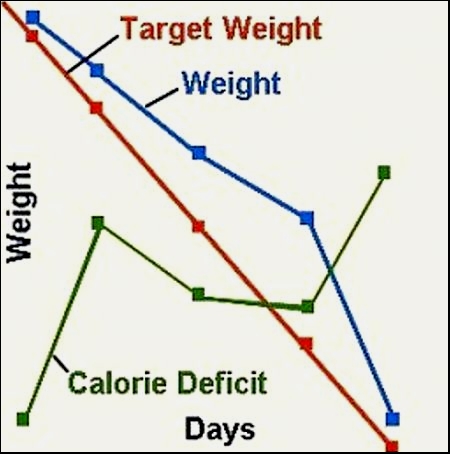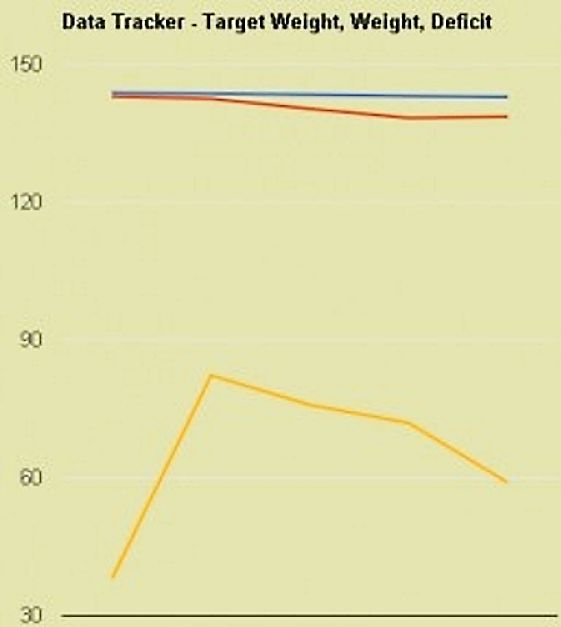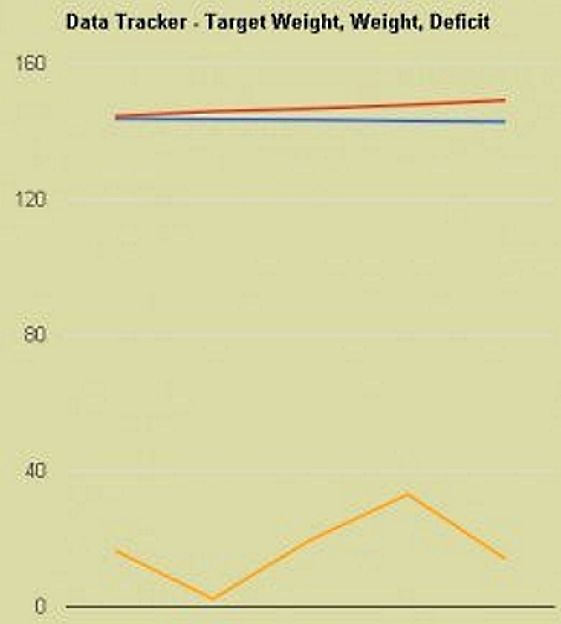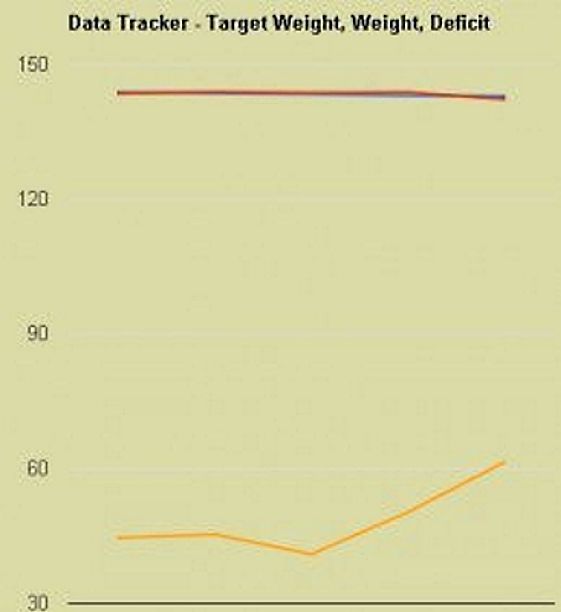Track Daily Calorie Deficit to Guarantee a Weight Loss Program
How can you guarantee you will lose weight and effectively monitor your progress towards your weight loss target?
Most systems for tracking weight loss are clumsy spreadsheets that are hard to use.
Many of the smartphone apps are far too time consuming, as you have to enter every individual meal or every item of food eaten, and log the details of every exercise session.
There has to be a better way of logging and tracking your daily weight, compared to your target weight and tracking your calorie deficit, and getting simple graphs so that you can see how you are going.
Well now there is such as simple system - Track your Calorie Deficit

What is a Calorie Deficit and How can Monitoring it Guarantee you will Lose Weight?
A Calories Deficit is simply the difference between what calories you burn through your basic metabolism in maintaining your body, the extra calories you burn through exercise, and the calorie ingested in the food you eat.Calorie Deficit = Calorie Burnt - Calories Eaten
- If you burn more calories than you eat - your body must get the extra energy from somewhere - hopefully your fat reserves.
- If you eat more calories than you burn your body may lay down the extra calories as fat.
It's a bit like saving money. It you want to save $50 per week you have to ensure that your income exceeds what you spend by $50. If you want to lose weight you have to ensure the calories you eat are less than the calories you burn and that your body has to draw from your 'bank' reserves ('fat') to make up the difference.
To guarantee a weight loss program you need a way of keeping records and monitoring your progress. In a sense you need a 'scare graph' - that is a graph which compares your weight each day with the weight you should have, if you are meeting your target. You have to know whether you are on track to meet your goals.
Lets say you set a weight loss target of 1 pound or 0.5 kg per week. If your weight at the start is 200 pounds (100 kg) at the end of the first week your target weight is 199 pounds or 99.5 kg.
So what you need is a way of tracking your weight each day and comparing it with your target weight. If you are not on track the graph will hopefully 'scare' you into action. he more you fall behind the harder it will be to get back in track - you will have failed your guarantee.
If your progress slows or perhaps you put on weight you need to make changes in your program. But how do you know what to do?
This is where the calorie deficit becomes very useful. To calculate the daily calorie deficit you need the following bits of information.
- Resting Metabolic Rate (RMR) - This is simply the amount of calories your body burns during typical daily activities. It varies between men and women and also with age and activity level. There are lots of websites you can use to estimate your RMR which will typically be between 1500 and 2700 calories per day. This is generally constant for any given person, but depends on body weight.
- Calories burnt through various exercises such as walking, running or cycling. There are many websites that can be used to estimate calories burnt. Most people have one or two exercises that they do regularly, and so it is simply a matter of working out a set of values and recording them on a daily basis. For example: A slow walk for about an hour consumes about 350 calories; A Run at a moderate pace for half an hour consumes about 470 calories.
- Total Calories Burnt is simply your RMR + extra calories burnt through exercise.
- Your total Calorie intake is simply the sum of all the calories in the main meals, snacks and drinks you ingest each day.
- One pound of body fat represents about 3450 calories (1 kg of fat equates to about 7700 calories). To lose a pound of fat will require a calorie deficit of at least 345 calories a day for10 days to lose a pound of fat. To lose kg of fat will require a deficit of 770 calories for 10 days, or 335 calories for 20 days.
The online tracking system has a very simple basis setup as shown below which includes:
- Start Date
- Start Weight
- Loss Rate per week
- Resting Metabolic Rate
Daily Data Entry
The system generates a new day (including the target for that day, based on your loss rate) and adds it to the top of the record - which makes it easier.Every day you enter:
- Your Weight
- Total Calories Eaten
- Total Calorie Burnt
- The system then calculates your calorie deficit.
To guarantee weight loss you will need to keep the deficit within a particular range. Because of inaccuracies and individual variations the size of the deficit that works will vary between users.
Similarly you may need to increase the deficit if your progress stalls or slows down.
Now for the Magic - The tool allow you to plot your progress on a graph - including:
- your target weight
- your actual weight
- your estimated calorie deficit
Shown below are three examples.
Figure 1. Shows a weight loss program that is exceeding expectations the with daily weight (red) trending well below the target rate (blue) with a calorie deficit of about 50-70% of the Resting Metabolic Rate.

Figure 2. Shows a weight loss program that is not working with the daily weight (red) trending well above the target rate (blue) with a calorie deficit of about 20-30% of the Resting Metabolic Rate. This deficit is far to low to work.

Figure 3. Shows a weight loss program that working at the target rate with the daily weight (red) matching the trend of the target rate with a calorie deficit of about 40-50% of the Resting Metabolic Rate.

The plots and the calculated deficit information listed in the table provide a very good way to monitor the progress of your weight loss program and to make adjustments.
The plot of actual weight versus the target weight provides a 'scare graph'. If the program is not working and you are not losing weight at the rate you specified you need to increase the deficit. You can examine the table to see the deficit levels that have not worked and see how to increase the deficit. You may increase the amount of exercise or decrease the amount of food you are eating (probably both).
Many people experience a plateau in their weight loss program. This system allow you to easily see when it occurs and to rule out changes in eating patterns and exercises as the cause. You may simply need to increase the deficit to 'break out' of the resistance to further weight loss.